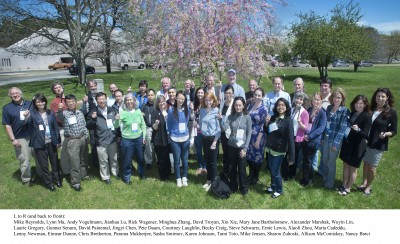First MAGIC Science Workshop a Wrap
Published: 6 August 2014
Editor’s note: Ernie Lewis, principal investigator for the Marine ARM GPCI Investigations of Clouds (MAGIC) field campaign, sent this update.
It’s hard to believe it’s been over a year since I was on the Spirit launching weather balloons, but it has. It has also been some time since the last MAGIC update, so I’ll try to catch everyone up on developments and current activities.

In May I organized the First MAGIC Science Workshop, which was held at Brookhaven National Laboratory (BNL). The goals of the workshop were to discuss the status of MAGIC activities, to allow investigators to present preliminary results, to determine what topics require attention in order to move forward with model intercomparisons and other analyses, to establish networking and collaborative possibilities, and to decide on future MAGIC activities. The meeting was well attended, with around 40 physical attendees and another dozen who attended remotely using Skype. Participants traveled from the US, Canada, and Finland, and there were also remote attendees from the US, England, and Israel. A range of affiliations were represented, including governmental organizations (US national laboratories, the Finnish Meteorological Institute, JPL, NASA, and NOAA), private companies, and nearly a dozen universities. The presentations on the first day of the workshop were on the MAGIC data sets, providing context, information on availability, and concerns with various data sets.
The presentations on the next day focused on science questions that have been, can be, or will be addressed with MAGIC data. All of the presentations (some of them given remotely) invoked much discussion. On the morning of the third day discussions were recapped, near-term analyses and future plans were discussed, actions that would be helpful in analyzing MAGIC data were listed, and charges were finalized. Overall, it was quite a success with many collaborations being formed and plans made.
People have already started analyzing some of the data sets, and I know of at least three papers that have been submitted involving MAGIC data. I attended an international conference two weeks ago at which I presented a poster on MAGIC data and discussed MAGIC with a number of people: A friend from Korea said that one of his students will be working on MAGIC data, another colleague from England plans to have a student work on MAGIC data, and some colleagues from Germany are also planning on working on some aspects of MAGIC. I was, naturally, very happy to hear this, and look forward to working with all of them.
Data are still being processed before being sent to the data archive, where they are freely available to all. Scientists in charge of the instruments have been looking over the data to ensure they are of highest quality. This involves making corrections based on later calibrations, flagging data points when the instruments weren’t working correctly, and similar activities. A data set of ship motions, necessary for data from radars and other upward-pointing instruments, is being finalized, and other data sets will use this one in their processing.
Ernie Lewis
The ARM Climate Research Facility is a DOE Office of Science user facility. The ARM Facility is operated by nine DOE national laboratories, including .
Keep up with the Atmospheric Observer
Updates on ARM news, events, and opportunities delivered to your inbox
ARM User Profile
ARM welcomes users from all institutions and nations. A free ARM user account is needed to access ARM data.


















